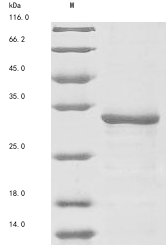Recombinant Mouse Tripeptidyl-peptidase 2 (Tpp2) is produced using a baculovirus expression system and includes amino acids 44 to 264. This partial protein carries an N-terminal 10xHis-tag and a C-terminal Myc-tag, which makes purification and detection more straightforward. SDS-PAGE analysis shows the protein purity exceeds 85%, indicating it should work well as a research reagent.
Tripeptidyl-peptidase 2 (Tpp2) appears to be a key protease that breaks down oligopeptides inside cells. The protein likely plays an important role in protein turnover and seems to be involved in various cellular processes, including immune response regulation. As part of the proteasome-associated complex, Tpp2 may be crucial for maintaining cellular protein balance, which makes it particularly interesting for researchers studying cell biology and immunology.
Potential Applications
Note: The applications listed below are based on what we know about this protein's biological functions, published research, and experience from experts in the field. However, we haven't fully tested all of these applications ourselves yet. We'd recommend running some preliminary tests first to make sure they work for your specific research goals.
Mouse Tpp2 is a serine peptidase that requires precise folding, proper active site formation, and specific tertiary structure for its enzymatic activity. The baculovirus expression system provides a eukaryotic environment that supports proper folding, disulfide bond formation, and potential post-translational modifications. However, the partial fragment (44-264aa) may lack critical domains necessary for full enzymatic activity, such as the complete catalytic site or oligomerization interfaces. The dual N-terminal 10xHis-tag and C-terminal Myc-tag may cause some steric interference but are unlikely to completely disrupt folding in this system. The probability of correct folding is high due to the expression system, but functional peptidase activity requires experimental validation since the fragment is incomplete.
1. Protein-Protein Interaction Studies
This application carries significant risk without domain validation. Tpp2 interactions often require full-length protein or specific domains not present in this fragment. If the fragment contains relevant interaction domains and is correctly folded (verified through structural assays), it may identify physiological partners. If misfolded or lacking domains, there is high risk of non-specific binding or tag-mediated artefacts.
2. Antibody Development and Validation
This application is highly suitable as antibody development relies on antigenic sequence recognition rather than functional folding. The fragment provides defined epitopes within the 44-264aa region for generating Tpp2-specific antibodies. The dual tags offer built-in controls for immunization and screening. However, antibodies may not recognize conformational epitopes of full-length Tpp2.
3. Structural and Biochemical Characterization
These studies are suitable for basic characterization of the fragment. Techniques like circular dichroism spectroscopy, dynamic light scattering, and analytical ultracentrifugation can assess folding, stability, and oligomeric state. However, results will not reflect full-length Tpp2 properties, and enzymatic activity cannot be assumed due to the partial nature.
4. Tag-Based Detection Assays
This application is highly suitable as it relies solely on tag detection. The dual His and Myc tags enable technical applications like sandwich ELISA, protein quantification, and purification optimization without requiring functional Tpp2 activity.
Final Recommendation & Action Plan
The baculovirus-expressed Tpp2 fragment with dual tags has a high probability of correct folding due to the eukaryotic expression system, but its functional utility is limited by the partial length. Begin with Application 3 (Structural Characterization) to validate folding quality through techniques like CD spectroscopy and SEC. Applications 2 and 4 (antibody development and tag-based assays) can proceed immediately. Application 1 (protein-protein interaction studies) requires prior validation that the fragment contains relevant interaction domains and is properly folded. For reliable Tpp2 functional studies, including enzymatic activity, use full-length protein expressed in a suitable system.






